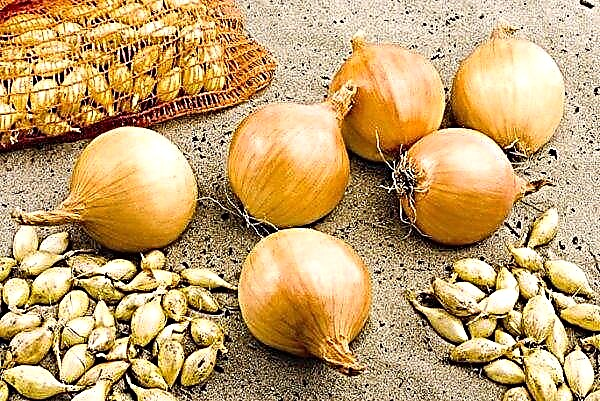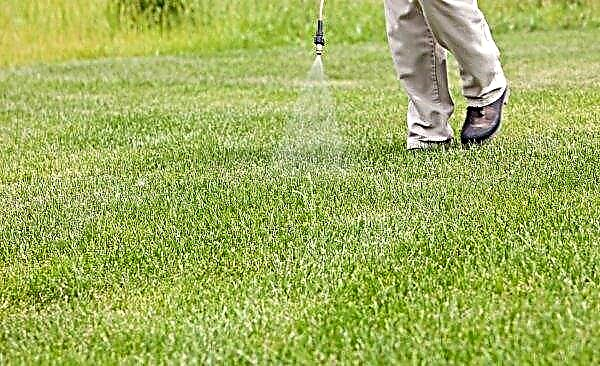Varroatosis is a disease characteristic of honey bees that causes a tick of varroa. One of the effective drugs designed to combat and prevent relapse of the disease is the drug "Bipin". How to dilute the medicine and is it possible to completely get rid of ticks with its help, read below.
How to detect ticks
Identifying ticks is quite simple. In winter, bees behave uneasily in hives infected with varroa. Insects absorb a lot of food and produce a large amount of waste. It is in the waste collected from the bottom of the hive and poured onto a white sheet of paper that mites are clearly visible.
The life expectancy of bee colonies is determined by the percentage of fattening, i.e. the number of parasites per 100 bees:
- 10% - low infection;
- 20% - average;
- over 20% - high.
Based on these indicators, dosages and type of treatments are selected.
To identify the degree of infection, it should be in the fall, before preparing the swarm for the winter, conduct the following analysis:
- Take 100 insects from the central part of the nest.
- Place them in a cup with hot (+ 40 ° C) water and add a pinch of washing powder.
- After mixing and settling to the bottom of ticks, calculate their number.
Important! Late uterine feeding with sugar syrup encourages them to lay eggs. Accordingly, with late brood, new parasite colonies begin to breed, which will not be possible to cope with in winter, which will lead to increased losses in bee colonies.
Pharmacological action and composition
In beekeeping, Bipin gained wide popularity due to its acaricidal properties and relative safety for bees themselves. The main active ingredient of the drug (amitraz) is an organic compound of synthetic origin. It belongs to the group of triazonpentadiene. In its pure form without impurities is a white crystalline powder.
The drug is packaged in 0.5 ml glass ampoules, which is 10 doses - this means that this amount is enough to process 10 hives of 5 small streets in each.
The substance is not harmful to bee families, does not affect the productivity and ability to reproduce their own kind. For warm-blooded animals it has a moderate danger (3rd hazard class). It has a systemic and contact acaricidal effect on ticks.
How and when is it best to process bees with Bipin
The time and timing of processing play the most important role in the treatment of bee colonies for ticks. To begin with, it’s worth figuring out what month and how many times to carry out manipulations so as not to provoke the death of a brood, since the Bipin acts destructively on it. Accordingly, spring treatments will be ineffective and only cause harm.
Tick control is carried out only when they are on adult bees, and there is no closed brood in the hive. Female ticks breed in closed cells of the honeycombs, and during this period of time trying to destroy them will be a futile occupation. The most correct option is autumn double treatment in October. It is also worth considering the weather conditions at the time of the medical procedures. It is best to carry them out in dry, calm weather and only at positive temperature indicators.
In the fall, treatment is much easier. The bees are heaped up and do not fly apart, so it’s easier to apply the product on them and you can do without using a mask.
Processing can be carried out using:Important! After opening the ampoule, the powder can be stored until the expiration date. The diluted solution can be used within 12 hours, the remains must be disposed of.
- syringes and droppers connected to a plastic bottle;
- smoke guns with a turntable.
Manipulations are carried out 2 times:
- the first - immediately after the honey collection in September;
- the second - before wintering in October.
If the hive is slightly affected by mites (10% or less per 100 bees), repeated treatment is not required, one after the honey collection will be enough.

Instructions for processing bees "Bipin"
When processing bees with the considered agent, it is important to correctly calculate the dosage so as not to provoke the death of most individuals, as well as prepare all the materials in advance.
Solution preparation
To prepare the solution, you need to boil the water, cool it to + 40 ° C and dilute the powder in it. For every 0.5 ml of the drug, 1 liter of water is consumed. After mixing with water, a milky-white homogeneous liquid should be obtained.
For processing, you will need to prepare:
- measuring cup or plastic bottle of 1.5 l;
- automatic syringe;
- needle from a dropper.
You can use several syringes, after having previously collected the necessary amount of liquid in them, so as not to waste time in the process of carrying out the manipulations. If a plastic bottle is used, then you need to make a hole in the cork and connect the tube from the dropper. A working solution is poured through the tube. Spraying the liquid is very convenient. To do this, just squeeze a little bottle.
Did you know? In one day, one bee can inspect an area of 12 hectares in search of food and nectar.
Dosage calculation
For each individual, 10 μg of the working solution is consumed. If there are few bees in the hive, then a smaller amount should be spent on each individual - 5-8 micrograms. On average, 10 ml of the drug goes to one street.
Processing process
The optimum air temperature during hive processing is +1 ... + 5 ° С.
Step-by-step process for processing the hive:
- Prepare containers with a solution of the drug.
- Remove the cover.
- Wrap the canvas to open 2-3 streets.
- Spray 10 ml of the working solution into 1 small street and cover it back with canvas.
- Continue handling in a similar manner for untreated areas.
- After 4 days, remove scuffing and debris.
If the bees are aggressive, then it is better to process only 1 street.
Video: Bipin Bee Processing in Autumn
The nuances of processing smoke-gun
This device greatly facilitates the work. With it, you can process the entire hive at once, and not the streets in turn. The working solution is placed in a special tank, from which it will evaporate under the influence of high temperature and fed into the hive through a fume. For smoke guns, the solution is prepared in a similar way. 50 ml of solution is placed in the tank before processing each subsequent hive.
Work safety measures
Beehives need to be treated with precautionary measures, as when working with moderately toxic pesticides. The possibility of contact with treated insects for up to 24 hours should be excluded.
In the first treatment, the substance should not be immediately applied on the whole hive. First you need to check it for safety for insects and the therapeutic effect. To do this, first process several families of bees and observe the reaction throughout the day.
Complete apiary processing is carried out only with the participation of a veterinarian.Important! An overdose of the drug can cause the death of bee colonies.
To ensure your own safety, you must follow these rules:
- Use protective gloves and an RPG respirator with “B” cartridges.
- Do not drink or smoke during handling.

Bipin is an effective drug of acaricidal action. It is highly effective in combating ticks parasitizing on honey bees. When carrying out treatments, the main thing is to observe the proportions and precautions.













